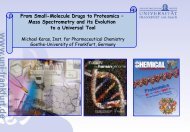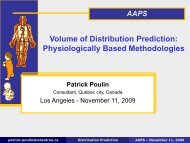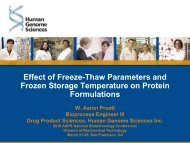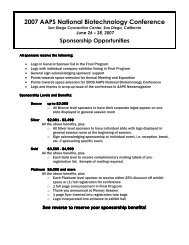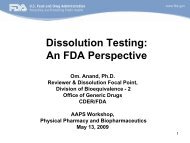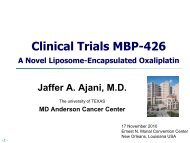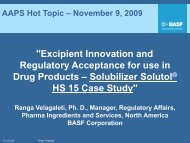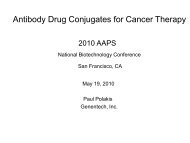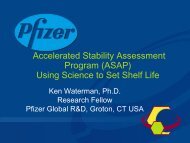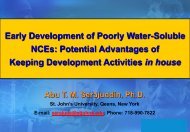Preliminary Program - American Association of Pharmaceutical ...
Preliminary Program - American Association of Pharmaceutical ...
Preliminary Program - American Association of Pharmaceutical ...
Create successful ePaper yourself
Turn your PDF publications into a flip-book with our unique Google optimized e-Paper software.
80<br />
2009 AAPS Annual Meeting and Exposition<br />
AAPS Regulatory Sciences (RS) <strong>Program</strong>ming<br />
Moderator<br />
Umang Shah, Ph.D.<br />
Solvay<br />
FDA’s Perspective<br />
Moheb Nasr, Ph.D., invited<br />
U.S. Food and Drug Administration<br />
USP Perspective on Performance Related Tests<br />
for Excipients<br />
Kevin Moore, Ph.D.<br />
United States Pharmacopeia<br />
Excipient User’s Perspective<br />
Mohan Ganapathy, Ph.D.<br />
Merck and Co., Inc.<br />
Excipient Manufacturer’s Perspective<br />
Richard C. Moreton, Ph.D.<br />
Finnbrit Consulting<br />
WEDNESDAY AFTERNOON ROUNDTABLES<br />
2:00 pm – 4:00 pm<br />
Comparator Products — Untold Stories<br />
Roundtable<br />
Conducting global clinical studies for later phases<br />
<strong>of</strong> development (Phase II – Phase III) requiring the<br />
use <strong>of</strong> comparator products presents an array <strong>of</strong> CMC<br />
challenges. These challenges are further enhanced<br />
in double-blinded studies where a placebo matching<br />
the comparator is required. <strong>Pharmaceutical</strong><br />
companies use over-encapsulation as a tool to blind<br />
the comparator and its matching placebos. This technique<br />
has its limitations, and CMC challenges, some<br />
<strong>of</strong> which include the need for conducting BA/BE studies,<br />
setting comparators’ specifications, the utility<br />
<strong>of</strong> the appropriate analytical tests and the accompanying<br />
validation studies to support these tests,<br />
and conducting the appropriate stability program to<br />
establish the shelf-life <strong>of</strong> these comparators once<br />
over-encapsulated. <strong>Pharmaceutical</strong> companies also<br />
manufacture matching placebo products that look<br />
exactly the same as the comparator product used.<br />
The main CMC challenge encountered when conducting<br />
these studies include the successful manufacture<br />
<strong>of</strong> a matching placebo with no infringement on trademarks.<br />
Additional challenges include the setting <strong>of</strong><br />
the appropriate specifications and shelf-life for the<br />
matching placebo. Formulation changes, excipient<br />
changes, and variations in dosage strengths are also<br />
critical issues to be addressed when conducting<br />
global clinical studies. The strategy for selecting the<br />
appropriate “comparator product” requires close<br />
collaboration between regulatory, regulatory-CMC,<br />
clinical supplies operations, manufacturing, and<br />
clinical to successfully conduct these studies. This<br />
roundtable will address the blinding strategies, best<br />
practices, and inter-functional collaboration leading<br />
to the appropriate choice <strong>of</strong> comparator product<br />
and the successful conduct <strong>of</strong> these global studies.<br />
Moderators<br />
Kim Huynh-Ba, M.S.<br />
PHARMALYTIK<br />
Ruben Lozano, Ph.D.<br />
Bristol-Myers Squibb<br />
Development <strong>of</strong> Dissolution Methods for<br />
Comparator Products — The Unspoken<br />
Challenges<br />
Qingxi Wang, Ph.D.<br />
Merck and Co., Inc.<br />
Bioavailability Challenges for Comparator<br />
Products<br />
Dakshina M. Chilukuri, Ph.D.<br />
U.S. Food and Drug Administration<br />
Regulatory Expectations for Comparator<br />
Product Use in Clinical Trials<br />
Speaker to be Determined<br />
WEDNESDAY AFTERNOON SYMPOSIA<br />
funded by a grant from<br />
2:00 pm – 4:30 pm<br />
Using the Quality-by-Design Principle<br />
to Establish <strong>Pharmaceutical</strong> Equivalence<br />
and Bioequivalence <strong>of</strong> Advanced<br />
Dosage Forms<br />
Symposium<br />
With the advances in pharmaceutical science and<br />
technology, there is increasing growth in novel dosage<br />
forms and drug delivery systems. Including many<br />
modified release dosage forms, liposomal products,<br />
drug-eluting stents, and possibly nanotech-derived<br />
pharmaceuticals in the near future. Given the complexicity<br />
<strong>of</strong> these advanced dosage forms, a number<br />
<strong>of</strong> challenges have been presented to industry and<br />
regulatory scientists in assessing pharmaceutical<br />
equivalence and bioequivalence, hence therapeutic<br />
equivalence. To achieve equivalence <strong>of</strong> these dosage<br />
forms, the U.S. Food and Drug Administration is<br />
currently encouraging drug sponsors to use a more<br />
systematic approach, such as quality-by-design<br />
(QbD) principle, for pharmaceutical development and<br />
manufacturing. Recently, it has been proposed that<br />
equivalence may be established by matching the test<br />
and reference in vivo drug delivery pr<strong>of</strong>iles (iDDPs)<br />
before drug absorption. With the application <strong>of</strong> QbD<br />
principle, this can be achieved by first characterizing<br />
the key component(s) <strong>of</strong> the reference iDDP and then<br />
using this information as the target for development<br />
<strong>of</strong> a test product. Critical variables or parameters<br />
may be identified to serve as in vitro markers or<br />
biomarkers for mapping the desired iDDP. Successful<br />
design <strong>of</strong> an equivalent test product can ultimately be<br />
accomplished with a better understanding <strong>of</strong> relevant<br />
factors that may have potential impact on the iDDPs<br />
<strong>of</strong> products in comparison. This session will bring<br />
together pharmaceutical scientists from industry, academia;<br />
and the regulatory agency to discuss how to<br />
use QbD principle and iDDPs to demonstrate equivalence<br />
<strong>of</strong> these dosage forms pre- and post-approval,<br />
identify critical factors that may have impact on iDDPs<br />
and product quality/performance, hence equivalence<br />
<strong>of</strong> advanced dosage forms, and explore various tools<br />
to assess the iDDPs <strong>of</strong> these dosage forms.<br />
Moderator<br />
Vincent H.L. Lee, Ph.D.<br />
The Chinese University <strong>of</strong> Hong Kong<br />
Equivalence-by-Design: Targeting Preabsorption<br />
Drug Delivery Pr<strong>of</strong>iles to Ensure<br />
Equivalence<br />
Mei-Ling Chen, Ph.D.<br />
U.S. Food and Drug Administration<br />
Critical Formulation Factors for Establishing<br />
Equivalence <strong>of</strong> Modified Release Dosage<br />
Forms<br />
James Polli, Ph.D.<br />
University <strong>of</strong> Maryland<br />
Application <strong>of</strong> Imaging Technique in<br />
Bioequivalence Testing<br />
Karsten Madar, Ph.D.<br />
Martin-Luther-University <strong>of</strong> Halle<br />
Biorelevant Dissolution and QbD for ANDAS<br />
Lawrence X. Yu, Ph.D.<br />
U.S. Food and Drug Administration<br />
2:00 pm – 4:30 pm<br />
Microdialysis Role in the Development<br />
and Optimization <strong>of</strong> Drug Topical<br />
Delivery<br />
Symposium<br />
The rapid and efficient development and evaluation<br />
<strong>of</strong> topical delivery systems is still a challenge,<br />
particularly when new approaches or devices<br />
like iontophoresis are tested. In vivo cutaneous<br />
microdialysis allows studying drug delivery and<br />
pharmacokinetics as close as possible to the site <strong>of</strong><br />
action and provides a tremendous tool for a better<br />
understanding <strong>of</strong> how the formulation affects drug<br />
PK into the skin. The proposed symposium will start<br />
with an overview <strong>of</strong> the microdialysis technique<br />
as applied to skin issues and will compare it with<br />
the other methods used to study PK in skin or<br />
skin layers. Then some <strong>of</strong> the available studies<br />
that utilized MD in skin will be presented and<br />
discussed. An expert from the U.S. Food and Drug<br />
Administration (FDA) will also be invited to provide<br />
insights into the regulatory aspects <strong>of</strong> the technique.<br />
The symposium will provide the attendee with the<br />
opportunity to evaluate the contribution <strong>of</strong> MD to<br />
improve our understanding <strong>of</strong> skin delivery.



